Analyzing Communication: Health & Social Care Organizational Systems
VerifiedAdded on 2024/06/03
|6
|1029
|349
Essay
AI Summary
This essay discusses the critical role of communication within health and social care organizations, highlighting the influence of values and cultural factors on the communication process. It analyzes how organizational systems and policies promote effective communication practices, referencing relevant legislation like the Equal Opportunity Act and the Human Rights Act. The essay suggests practical methods for enhancing communication, such as feedback mechanisms, team-building events, and rotational team assignments. It concludes that adopting these strategies, along with valuing diverse cultures and beliefs, will significantly improve communication and build stronger relationships among healthcare workers. Desklib offers a wealth of similar resources for students seeking past papers and solved assignments.
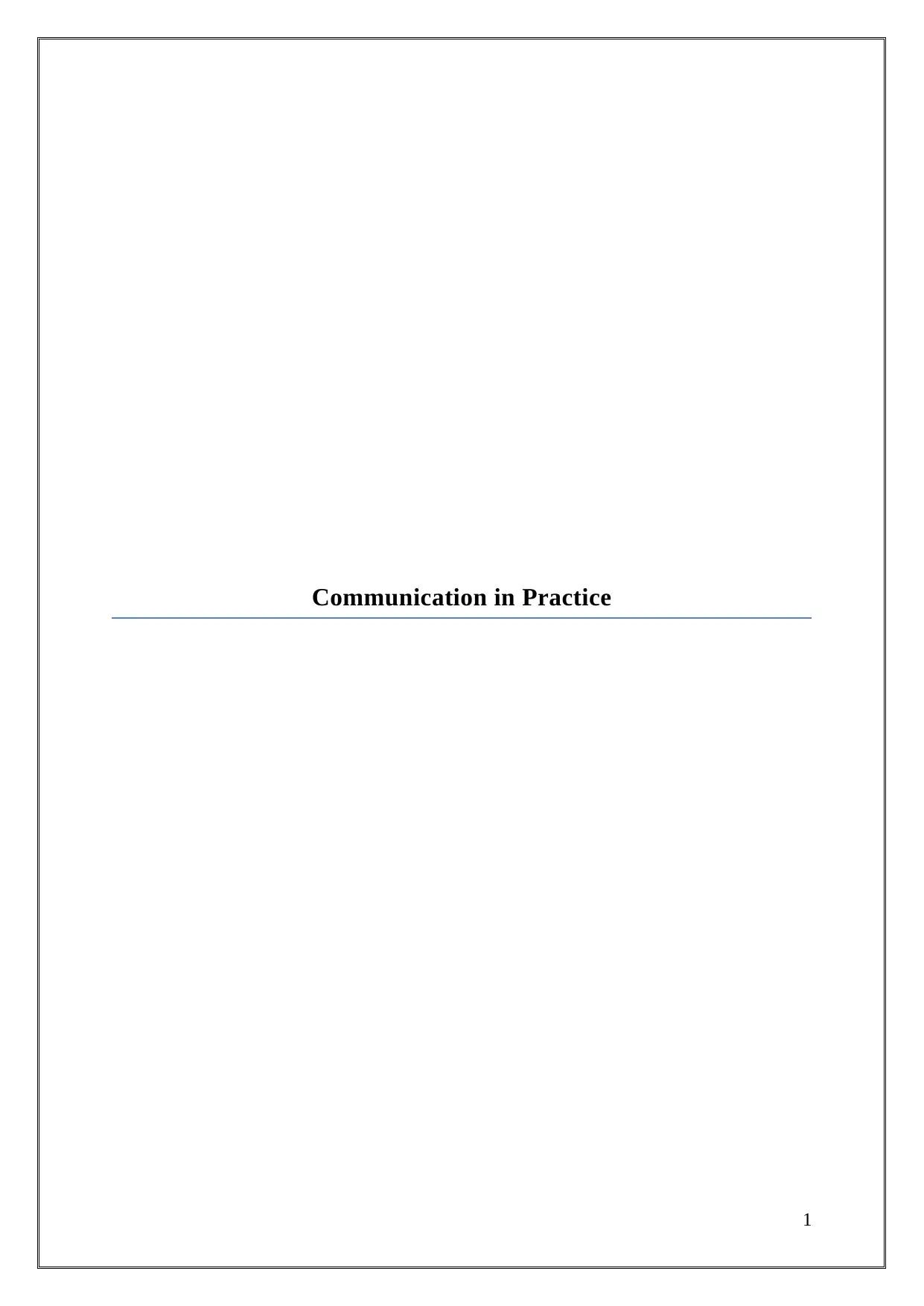
Communication in Practice
1
1
Paraphrase This Document
Need a fresh take? Get an instant paraphrase of this document with our AI Paraphraser
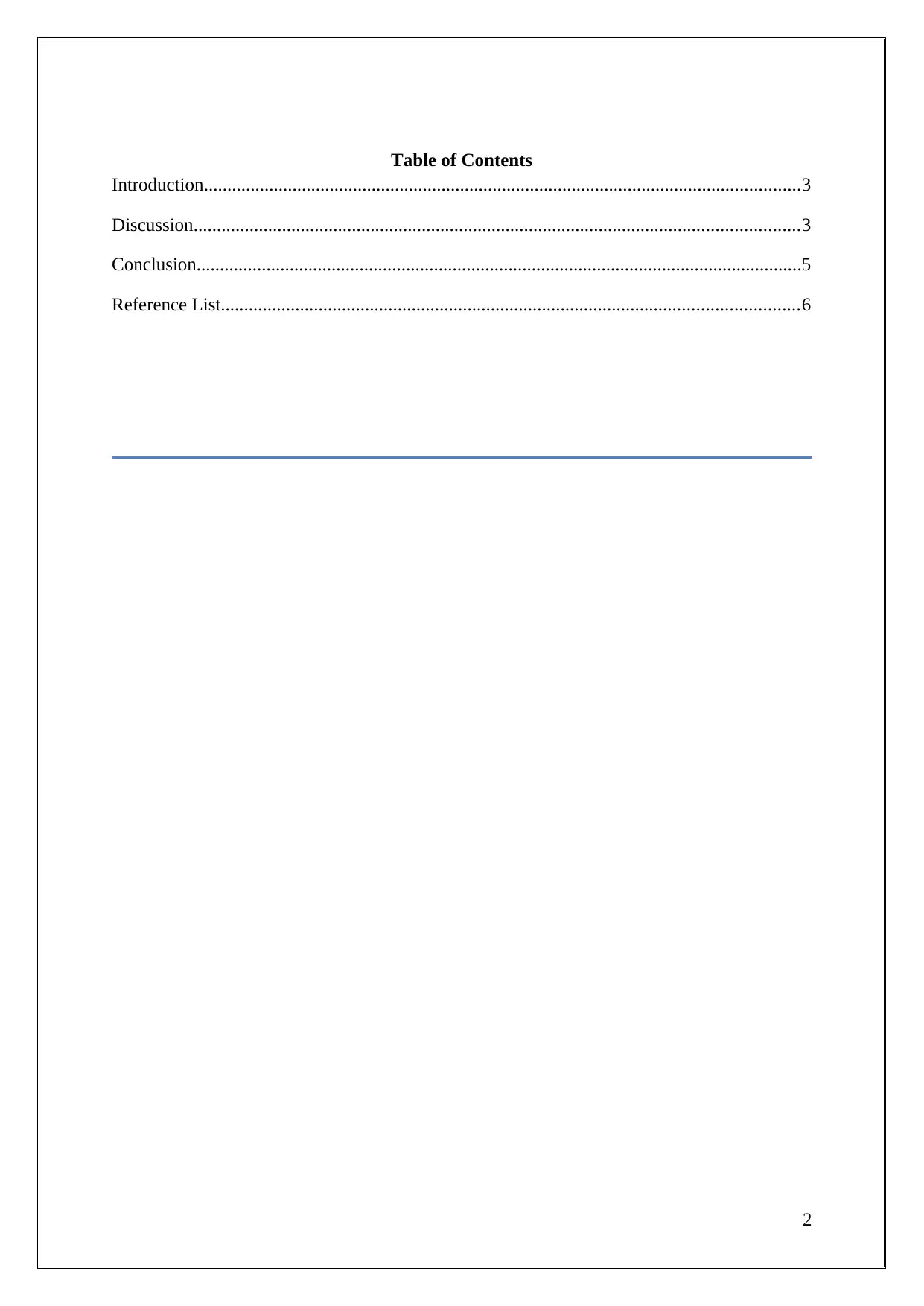
Table of Contents
Introduction................................................................................................................................3
Discussion..................................................................................................................................3
Conclusion..................................................................................................................................5
Reference List............................................................................................................................6
2
Introduction................................................................................................................................3
Discussion..................................................................................................................................3
Conclusion..................................................................................................................................5
Reference List............................................................................................................................6
2
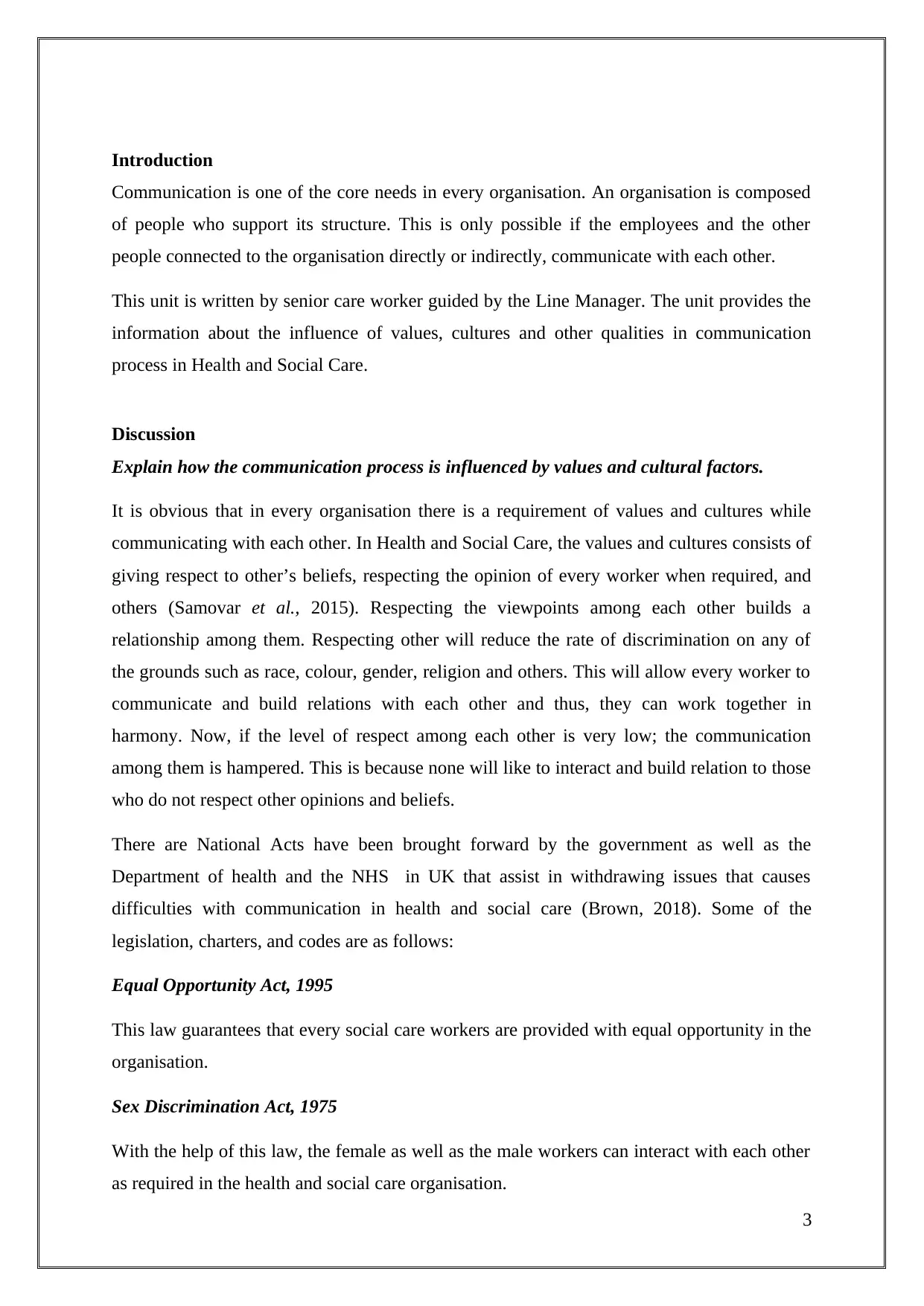
Introduction
Communication is one of the core needs in every organisation. An organisation is composed
of people who support its structure. This is only possible if the employees and the other
people connected to the organisation directly or indirectly, communicate with each other.
This unit is written by senior care worker guided by the Line Manager. The unit provides the
information about the influence of values, cultures and other qualities in communication
process in Health and Social Care.
Discussion
Explain how the communication process is influenced by values and cultural factors.
It is obvious that in every organisation there is a requirement of values and cultures while
communicating with each other. In Health and Social Care, the values and cultures consists of
giving respect to other’s beliefs, respecting the opinion of every worker when required, and
others (Samovar et al., 2015). Respecting the viewpoints among each other builds a
relationship among them. Respecting other will reduce the rate of discrimination on any of
the grounds such as race, colour, gender, religion and others. This will allow every worker to
communicate and build relations with each other and thus, they can work together in
harmony. Now, if the level of respect among each other is very low; the communication
among them is hampered. This is because none will like to interact and build relation to those
who do not respect other opinions and beliefs.
There are National Acts have been brought forward by the government as well as the
Department of health and the NHS in UK that assist in withdrawing issues that causes
difficulties with communication in health and social care (Brown, 2018). Some of the
legislation, charters, and codes are as follows:
Equal Opportunity Act, 1995
This law guarantees that every social care workers are provided with equal opportunity in the
organisation.
Sex Discrimination Act, 1975
With the help of this law, the female as well as the male workers can interact with each other
as required in the health and social care organisation.
3
Communication is one of the core needs in every organisation. An organisation is composed
of people who support its structure. This is only possible if the employees and the other
people connected to the organisation directly or indirectly, communicate with each other.
This unit is written by senior care worker guided by the Line Manager. The unit provides the
information about the influence of values, cultures and other qualities in communication
process in Health and Social Care.
Discussion
Explain how the communication process is influenced by values and cultural factors.
It is obvious that in every organisation there is a requirement of values and cultures while
communicating with each other. In Health and Social Care, the values and cultures consists of
giving respect to other’s beliefs, respecting the opinion of every worker when required, and
others (Samovar et al., 2015). Respecting the viewpoints among each other builds a
relationship among them. Respecting other will reduce the rate of discrimination on any of
the grounds such as race, colour, gender, religion and others. This will allow every worker to
communicate and build relations with each other and thus, they can work together in
harmony. Now, if the level of respect among each other is very low; the communication
among them is hampered. This is because none will like to interact and build relation to those
who do not respect other opinions and beliefs.
There are National Acts have been brought forward by the government as well as the
Department of health and the NHS in UK that assist in withdrawing issues that causes
difficulties with communication in health and social care (Brown, 2018). Some of the
legislation, charters, and codes are as follows:
Equal Opportunity Act, 1995
This law guarantees that every social care workers are provided with equal opportunity in the
organisation.
Sex Discrimination Act, 1975
With the help of this law, the female as well as the male workers can interact with each other
as required in the health and social care organisation.
3
⊘ This is a preview!⊘
Do you want full access?
Subscribe today to unlock all pages.

Trusted by 1+ million students worldwide
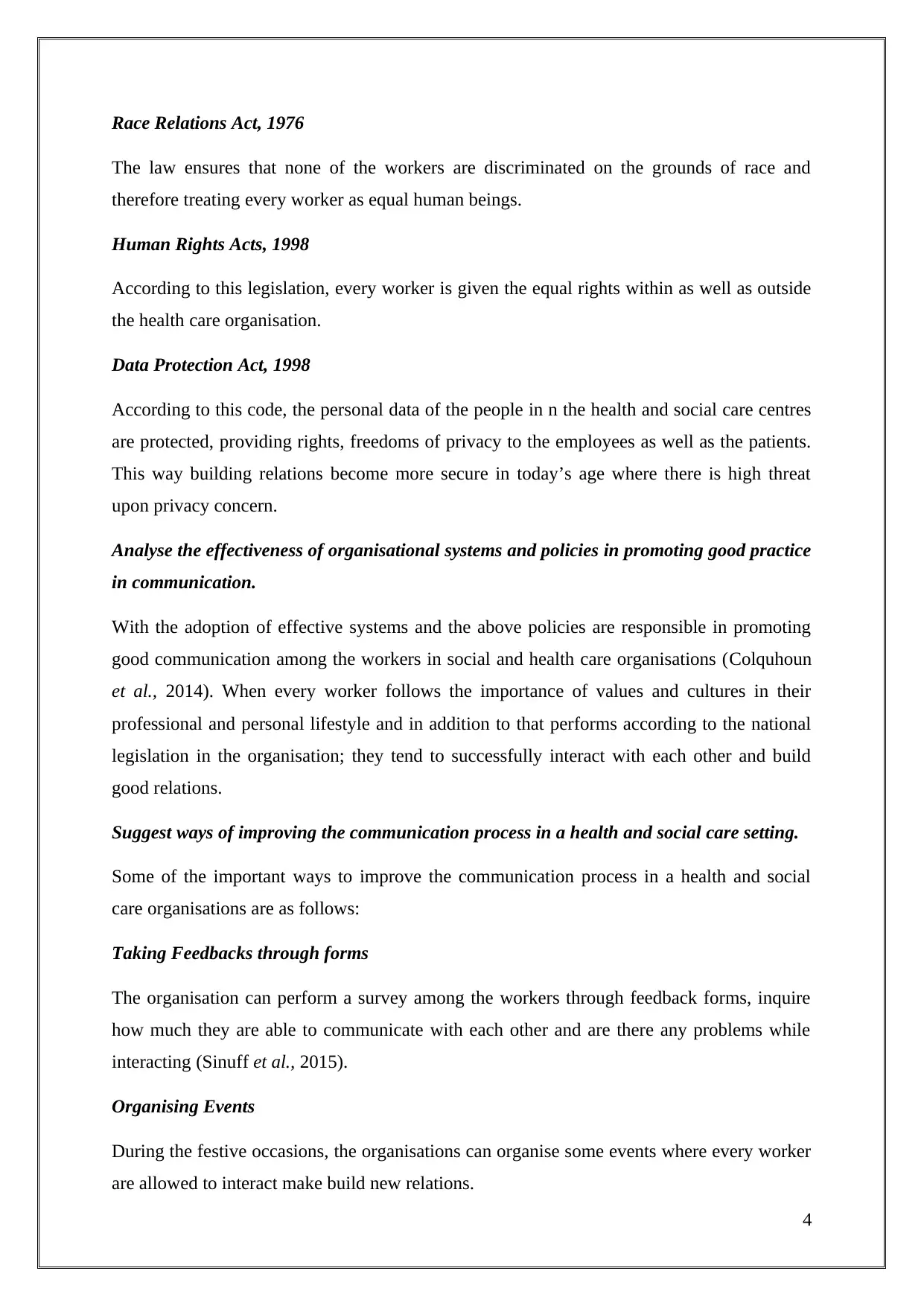
Race Relations Act, 1976
The law ensures that none of the workers are discriminated on the grounds of race and
therefore treating every worker as equal human beings.
Human Rights Acts, 1998
According to this legislation, every worker is given the equal rights within as well as outside
the health care organisation.
Data Protection Act, 1998
According to this code, the personal data of the people in n the health and social care centres
are protected, providing rights, freedoms of privacy to the employees as well as the patients.
This way building relations become more secure in today’s age where there is high threat
upon privacy concern.
Analyse the effectiveness of organisational systems and policies in promoting good practice
in communication.
With the adoption of effective systems and the above policies are responsible in promoting
good communication among the workers in social and health care organisations (Colquhoun
et al., 2014). When every worker follows the importance of values and cultures in their
professional and personal lifestyle and in addition to that performs according to the national
legislation in the organisation; they tend to successfully interact with each other and build
good relations.
Suggest ways of improving the communication process in a health and social care setting.
Some of the important ways to improve the communication process in a health and social
care organisations are as follows:
Taking Feedbacks through forms
The organisation can perform a survey among the workers through feedback forms, inquire
how much they are able to communicate with each other and are there any problems while
interacting (Sinuff et al., 2015).
Organising Events
During the festive occasions, the organisations can organise some events where every worker
are allowed to interact make build new relations.
4
The law ensures that none of the workers are discriminated on the grounds of race and
therefore treating every worker as equal human beings.
Human Rights Acts, 1998
According to this legislation, every worker is given the equal rights within as well as outside
the health care organisation.
Data Protection Act, 1998
According to this code, the personal data of the people in n the health and social care centres
are protected, providing rights, freedoms of privacy to the employees as well as the patients.
This way building relations become more secure in today’s age where there is high threat
upon privacy concern.
Analyse the effectiveness of organisational systems and policies in promoting good practice
in communication.
With the adoption of effective systems and the above policies are responsible in promoting
good communication among the workers in social and health care organisations (Colquhoun
et al., 2014). When every worker follows the importance of values and cultures in their
professional and personal lifestyle and in addition to that performs according to the national
legislation in the organisation; they tend to successfully interact with each other and build
good relations.
Suggest ways of improving the communication process in a health and social care setting.
Some of the important ways to improve the communication process in a health and social
care organisations are as follows:
Taking Feedbacks through forms
The organisation can perform a survey among the workers through feedback forms, inquire
how much they are able to communicate with each other and are there any problems while
interacting (Sinuff et al., 2015).
Organising Events
During the festive occasions, the organisations can organise some events where every worker
are allowed to interact make build new relations.
4
Paraphrase This Document
Need a fresh take? Get an instant paraphrase of this document with our AI Paraphraser
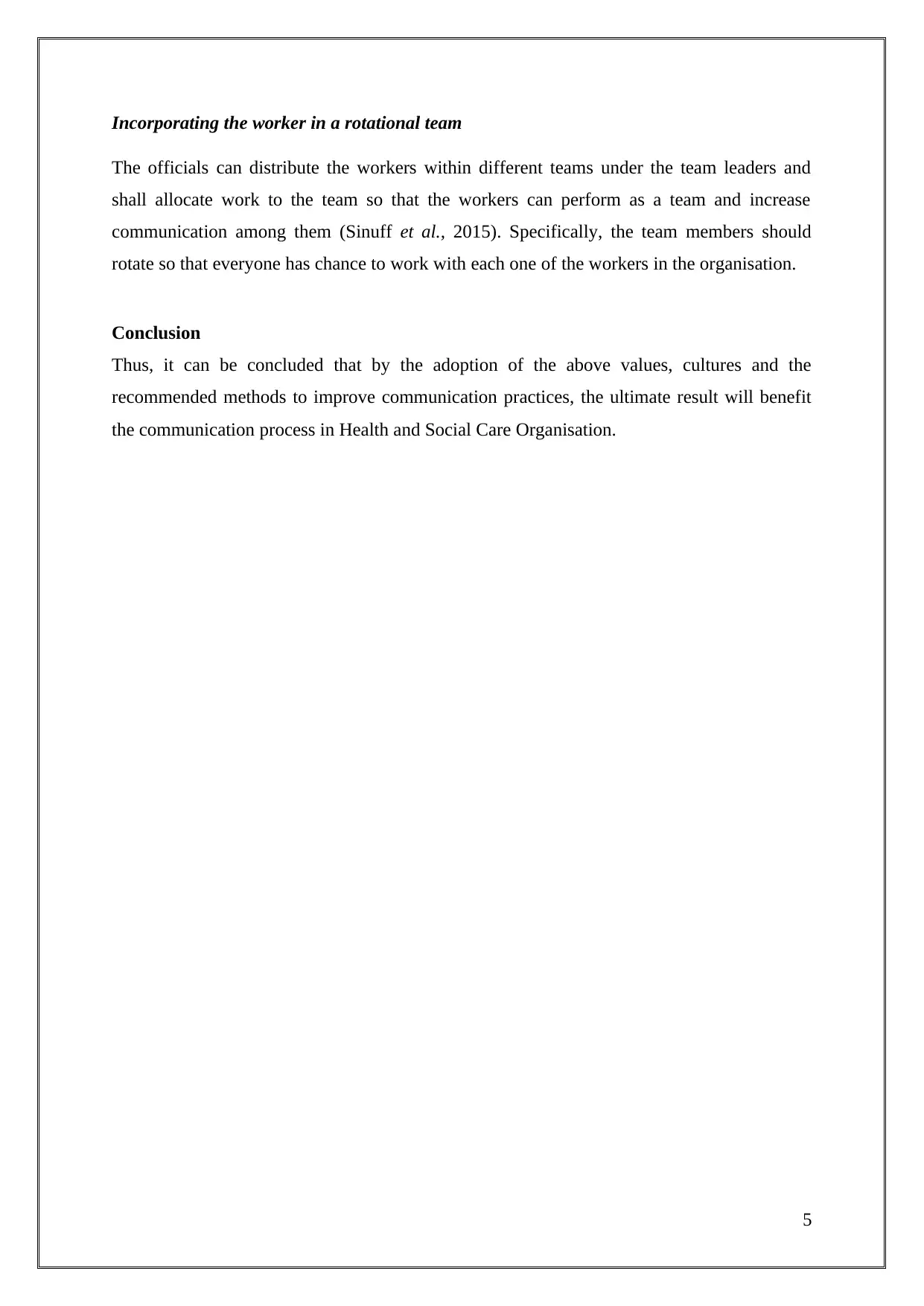
Incorporating the worker in a rotational team
The officials can distribute the workers within different teams under the team leaders and
shall allocate work to the team so that the workers can perform as a team and increase
communication among them (Sinuff et al., 2015). Specifically, the team members should
rotate so that everyone has chance to work with each one of the workers in the organisation.
Conclusion
Thus, it can be concluded that by the adoption of the above values, cultures and the
recommended methods to improve communication practices, the ultimate result will benefit
the communication process in Health and Social Care Organisation.
5
The officials can distribute the workers within different teams under the team leaders and
shall allocate work to the team so that the workers can perform as a team and increase
communication among them (Sinuff et al., 2015). Specifically, the team members should
rotate so that everyone has chance to work with each one of the workers in the organisation.
Conclusion
Thus, it can be concluded that by the adoption of the above values, cultures and the
recommended methods to improve communication practices, the ultimate result will benefit
the communication process in Health and Social Care Organisation.
5
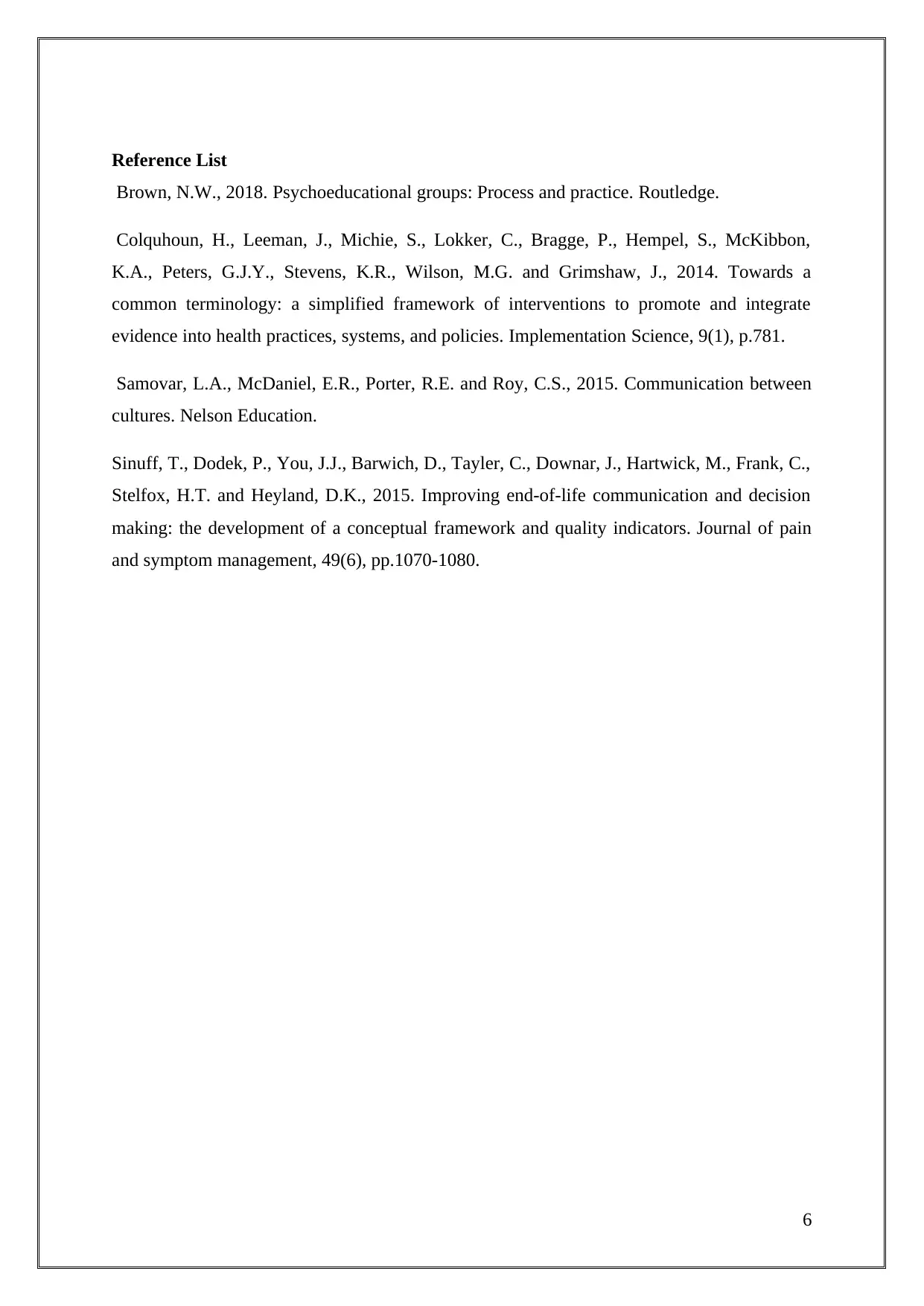
Reference List
Brown, N.W., 2018. Psychoeducational groups: Process and practice. Routledge.
Colquhoun, H., Leeman, J., Michie, S., Lokker, C., Bragge, P., Hempel, S., McKibbon,
K.A., Peters, G.J.Y., Stevens, K.R., Wilson, M.G. and Grimshaw, J., 2014. Towards a
common terminology: a simplified framework of interventions to promote and integrate
evidence into health practices, systems, and policies. Implementation Science, 9(1), p.781.
Samovar, L.A., McDaniel, E.R., Porter, R.E. and Roy, C.S., 2015. Communication between
cultures. Nelson Education.
Sinuff, T., Dodek, P., You, J.J., Barwich, D., Tayler, C., Downar, J., Hartwick, M., Frank, C.,
Stelfox, H.T. and Heyland, D.K., 2015. Improving end-of-life communication and decision
making: the development of a conceptual framework and quality indicators. Journal of pain
and symptom management, 49(6), pp.1070-1080.
6
Brown, N.W., 2018. Psychoeducational groups: Process and practice. Routledge.
Colquhoun, H., Leeman, J., Michie, S., Lokker, C., Bragge, P., Hempel, S., McKibbon,
K.A., Peters, G.J.Y., Stevens, K.R., Wilson, M.G. and Grimshaw, J., 2014. Towards a
common terminology: a simplified framework of interventions to promote and integrate
evidence into health practices, systems, and policies. Implementation Science, 9(1), p.781.
Samovar, L.A., McDaniel, E.R., Porter, R.E. and Roy, C.S., 2015. Communication between
cultures. Nelson Education.
Sinuff, T., Dodek, P., You, J.J., Barwich, D., Tayler, C., Downar, J., Hartwick, M., Frank, C.,
Stelfox, H.T. and Heyland, D.K., 2015. Improving end-of-life communication and decision
making: the development of a conceptual framework and quality indicators. Journal of pain
and symptom management, 49(6), pp.1070-1080.
6
⊘ This is a preview!⊘
Do you want full access?
Subscribe today to unlock all pages.

Trusted by 1+ million students worldwide
1 out of 6
Related Documents
Your All-in-One AI-Powered Toolkit for Academic Success.
+13062052269
info@desklib.com
Available 24*7 on WhatsApp / Email
![[object Object]](/_next/static/media/star-bottom.7253800d.svg)
Unlock your academic potential
Copyright © 2020–2025 A2Z Services. All Rights Reserved. Developed and managed by ZUCOL.





